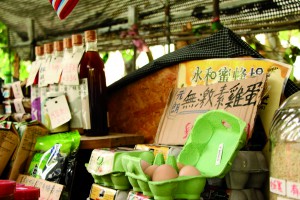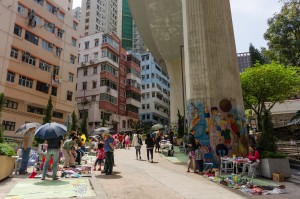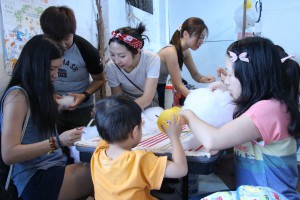Hong Kong’s market movement seeks to revive rural and urban communities from the bottom-up
By Zoe Tam
In Ma Shi Po village, just minutes away from Fanling’s high-rises, there is a hidden oasis of peaceful farmland – the Mapopo Community Farm.
At its peak, more than 700 families lived in the village, but most villagers moved out after indigenous villagers, who leased the land to them, signed the ownership over to property developers. Now, those who remain are left to face the threat of the government’s North East New Territories New Development plan.
Those villagers who have stayed behind and are helping to run the community farm are refusing to give up their way of life. They are organising tours and workshops to promote sustainable farming.
Every second and fourth Sunday is market day at Mapopo and the farm is filled with the sound of children’s laughter and animated conversations on topics ranging from food recipes to protest strategy in the campaign against urban encroachment.

Lau Shui-shum has been farming the local land since marrying into the village decades ago. She is busy sharing recipe ideas with customers interested in buying her organic produce. Her customers compliment her on the quality of her vegetables in return.
Lau is proud to recount a conversation she had with other customers about the future of the farm. “They were like, without you guys, I don’t know where to buy vegetables,” she says.
Before the Mapopo Community Farm was set up five years ago, life was very different for Lau. She would wake at 1 a.m. to first harvest and then take her crops to Fanling’s wholesale dawn market. As a small farmer, she had no grounds to bargain about the price and had to settle for less than she thinks she deserved.
Now, Lau can sleep until 6 a.m. and has complete control on setting prices as the market organisers do not charge farmers any rent or commission to sell their produce here. Lau is also glad the market gives her the opportunity to reach people from outside the village who care about local agriculture as much as she does.
“Hong Kong is not a big city…but if Hong Kong cannot supply some vegetables for locals, this is so wrong. Isn’t it?” she says.
Andy Wong Hiu-hei is a customer who shares this sentiment. He started visiting the market to learn more about the villagers’ way of life after the large-scale protest against funding for the Northeast New Territories Development plan last June.

Although the 42-year-old works in Central and lives in Lantau, he is happy to make the hour-long journey to the market and this is his fourth visit. Wong wants to support the market and show his appreciation for efforts to produce locally grown food. Wong says this and the market’s fair-trade practices inspire him to support local farming. “Hong Kong is a well-developed city and is financially capable of supporting people who would like to live differently. And diversity is one of the foundations of democracy,” he says.
Not all customers care about the survival of local farming when they first visit the place. But Zoey Wong Suk-wai, who works at the community farm, says they have gradually changed customers’ minds.
“At first, people visit the market just because they want to eat healthier, but later they start to care about their community and issues relevant to land and agriculture,” she says.
Zoey Wong says the market is a bridge between farmers and those from the outside. To further strengthen the bond between farm and community and the urban and the rural, the farm has launched a food waste recycling scheme to convert food waste collected in the area into fertilizer for the farm. Customers do not only play the role of consumers but also engage in production.
Wong blames the government for pushing the belief that the ideas behind urban and rural living contradict each other. She hopes the market can help to refute this notion.
“We hope to reconnect the community through this kind of agricultural activity to form a cycle. This is what we called urban-rural coexistence,” she says.
While Wong and villagers in Ma Shi Po Village hope to awaken the public to the value of living off the land and the possibility of self-sufficiency through reviving agriculture, others have been working on organising markets to revive urban communities.
The Supporting Grassroots and Market Alliance, founded in 2012 has held various markets including the large-scale Hong Kong Bazaars Festival Market from May to July this year. Their aim is to help the grassroots to eliminate poverty and link up different people in the community.
“Market is a ‘wishing tree’ as different people can do whatever they plan [in it]. I don’t care about your identity and source of income…You and I belong to this place and we can talk about a lot of things to rebuild relationships,” says Chiu Sin-ting, a spokesperson of the alliance.
Chiu says markets create an environment where residents can mingle and exchange information about job opportunities, health advice and other things relevant to their lives. These are experiences shoppers do not encounter in malls. They also give residents the chance to start their own businesses at a low cost.

During August, Chiu and her team ran the Sham Shui Po Daytime Market on every Sunday of the month. They wanted it to be a trial flea market that would show the government how markets could address the socioeconomic needs of grassroots communities in different districts.
Compared with other markets, where daily rent is more than HK$300 per stall, the 30 vendors who joined the scheme could sell dry goods rent-free without interference from the Food and Environmental Hygiene Department. They did not need to have hawker licenses and could set up their own stalls as they wished within a designated chalk square.
The group’s plan got positive feedback from the Sham Shui Po District Council and local residents but it still took nine months to make it happen. Chiu says they ran into many difficulties due to government bureaucracy and a lack of transparency. They had to fulfill many requirements stipulated by the Lands Department and Fire Services Department. The Independent Commission Against Corruption was also involved, to check whether the selection procedure for vendors was clean and fair.
While they were in the middle of dealing with red-tape and collecting residents’ opinions, they were challenged by critics asking why the government needed to offer a free site for members of the grassroots to make profits. “They just do not understand the benefits this market brought to the grassroots,” she laments.
Vincent Cheng Wing-shun*, the district councillor for Nam Cheong North who acted as an intermediary to connect the alliance with different people in the district, says residents’ concerns were mainly about noise, traffic, hygiene issues and security.
He adds that if the flea market becomes a regular event, he believes shop owners and licensed hawkers in the district will ask why the government subsidises vendors in the market by not charging them rent or requiring they pay for licenses.
In the case of Sham Shui Po, Cheng says the trial market might not have made a big impact in helping to bring local residents together because they were already a close-knit community. But he says it did successfully strengthen the younger generation’s feelings for and ties with Sham Shui Po.

“We hope to change their views through this, so they will start to consider Sham Shui Po not only as a place with ordinary goods but also with some cultural elements. They will get to know how the grassroots live,” says Cheng.
When it comes to strengthening community ties, 28-year-old Benny Yuen Chun-wai does not need any external encouragement. Yuen grew up in Tai Po and when he was offered the chance to transform and revive Tai Po’s old Luen Wo Market, he jumped at it. He helped to transform the former market building into the Luen Wo Village, a site for craftspeople to work and exchange ideas. In September, he organised a one-off Mid-Autumn market in the grade-three listed historical building.
At the event, visitors could savour traditional local snacks and buy handicrafts as well as locally grown vegetables. There was even free hairstyling available for lower-income families.
Yuen describes the event as “very local” and thinks it improved community bonding as many residents living nearby asked many questions about the market before it began.
Next, Yuen wants to invite an old footwear shop that used to make leather boots for the British colonial soldiers and young leather crafters to work together at the market.

“The older generation is equipped with knowledge which the young lack; the new generation has ideas the old are not aware of. Through this activity, I wish to connect the two generations,” says Yuen.
What he really wants to do is to change the government’s top-down approach to heritage preservation and youth development. He wants to use the market as a showcase, demonstrating that local community groups can perform the same functions using a bottom-up approach and at a lower cost.
His idea might sound radical and new but he is in fact merely following in the footsteps of the old villagers. In the 1950s, villagers from Fanling, Tai Po, Sha Tau Kok and Ta Ku Ling had already adopted a bottom-up approach to build Luen Wo Market through community funding. The market was extremely popular with the locals.
Today, the new Luen Wo Market is just as much of a resounding success. Where the old building had become empty and quiet, the Mid-Autumn event once again brought back lively crowds. This is no surprise to Yuen. “A market is the basic element for living in groups. Apart from providing a place for people to buy basic necessities, it is also where the cohesiveness lies in a community,” he says.
*Jordan Chan Wing-fai is also contesting the Nam Cheong North constituency in the upcoming District Council election
Edited by Kanis Leung











































